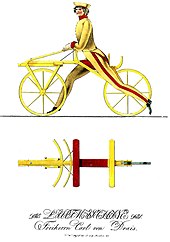Our website is made possible by displaying online advertisements to our visitors.
Please consider supporting us by disabling your ad blocker.
Draisine
This article needs additional citations for verification. (February 2021) |

A draisine (English: /dreɪˈziːn/) is a light auxiliary rail vehicle, driven by service personnel, equipped to transport crew and material necessary for the maintenance of railway infrastructure.
The eponymous term is derived from the German inventor Baron Karl Drais, who invented his Laufmaschine (German for "running machine") in 1817, which was called Draisine in German (vélocipède or draisienne in French) by the press. It is the first reliable claim for a practically used precursor to the bicycle, basically the first commercially successful two-wheeled, steerable, human-propelled machine, nicknamed hobby-horse or dandy horse.[1]

Later, the name draisine came to be applied only to the invention used on rails and was extended to similar vehicles, even when not human-powered. Because of their low weight and small size, they can be put on and taken off the rails at any place, allowing trains to pass.
In the United States, motor-powered draisines are known as speeders while human-powered ones are referred as handcars. Vehicles that can be driven on both the highway and the rail line are called road–rail vehicles, or (after a trademark) Hy-Rails.
- ^ "From Draisienne to Dandyhorse". Canada Science and Technology Museum. Archived from the original on 5 February 2012. Retrieved 16 August 2013.
Previous Page Next Page


